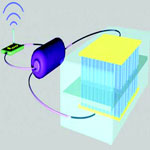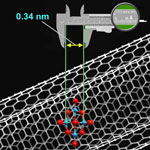Showing Spotlights 145 - 152 of 217 in category All (newest first):
 Naturally occurring nanomaterials can be found everywhere in nature and only with recent advances in instrumentation and metrology equipment are researchers beginning to locate, isolate, characterize and classify the vast range of their structural and chemical varieties. Scientists are beginning to recognize that all sources of nanomaterials are important in evaluating the possible impact of nanoscale materials on human health and the environment; however, perhaps the greatest benefit to studying these materials will be in their ability to inform researchers about the manner in which nano-sized materials have been a part of our environment from the beginning.
Naturally occurring nanomaterials can be found everywhere in nature and only with recent advances in instrumentation and metrology equipment are researchers beginning to locate, isolate, characterize and classify the vast range of their structural and chemical varieties. Scientists are beginning to recognize that all sources of nanomaterials are important in evaluating the possible impact of nanoscale materials on human health and the environment; however, perhaps the greatest benefit to studying these materials will be in their ability to inform researchers about the manner in which nano-sized materials have been a part of our environment from the beginning.
Nov 24th, 2011
 Colloidal silver is not a health elixir and should not be taken orally. Still, dubious online resources that sell silver dispersions or explain how to synthesize colloidal silver for nutritional purposes keep propagating mystic health effects of nano-silver. Whoever considers to "treat" themselves by taking colloidal silver certainly don't know what they want to treat themselves for. They should be aware that drinking an antimicrobial agent at any effectual dosage must inevitably cause harm to innumerable bacteria that are vital to our organism - especially in the alimentary canal. Drinking colloidal silver will either be noneffective or harmful. It is not medicine.
Colloidal silver is not a health elixir and should not be taken orally. Still, dubious online resources that sell silver dispersions or explain how to synthesize colloidal silver for nutritional purposes keep propagating mystic health effects of nano-silver. Whoever considers to "treat" themselves by taking colloidal silver certainly don't know what they want to treat themselves for. They should be aware that drinking an antimicrobial agent at any effectual dosage must inevitably cause harm to innumerable bacteria that are vital to our organism - especially in the alimentary canal. Drinking colloidal silver will either be noneffective or harmful. It is not medicine.
Nov 4th, 2011
 Today we are going to tackle a general topic that deals with how data is represented in scientific papers. The use of illustrations in scientifi c publications is a longstanding tradition that goes back thousands of years. In the course of writing 1,200 Nanowerk Spotlights over the past six years, we have worked our way through thousands of papers. And if one thing has stood out, it is the quality of the illustrations included in these papers: some are just excellent and capture the essence of the findings; others, well, let's just say they could be improved upon. Here are five specific recommendations on how scientists should design effective figures.
Today we are going to tackle a general topic that deals with how data is represented in scientific papers. The use of illustrations in scientifi c publications is a longstanding tradition that goes back thousands of years. In the course of writing 1,200 Nanowerk Spotlights over the past six years, we have worked our way through thousands of papers. And if one thing has stood out, it is the quality of the illustrations included in these papers: some are just excellent and capture the essence of the findings; others, well, let's just say they could be improved upon. Here are five specific recommendations on how scientists should design effective figures.
Sep 22nd, 2011
 It is quite difficult - not least because there is no consensus about a proper definition - to assess the scope of nanotechnology research and its impact on the overall scientific body as well as its commercialization prospects. In a new attempt to put some numbers behind the general perception of a rapidly expanding nanotechnology field, two researchers at UC Davis have trawled scientific databases and come up with some surprising findings. For instance, that China has now overtaken the USA in annual research paper output related to nanoscience and nanotechnology. Also, the proportion of "nano"-related articles relative to the total size of the subject categories (such as physics, materials sciences or chemistry) has risen dramatically over the past 13 years.
It is quite difficult - not least because there is no consensus about a proper definition - to assess the scope of nanotechnology research and its impact on the overall scientific body as well as its commercialization prospects. In a new attempt to put some numbers behind the general perception of a rapidly expanding nanotechnology field, two researchers at UC Davis have trawled scientific databases and come up with some surprising findings. For instance, that China has now overtaken the USA in annual research paper output related to nanoscience and nanotechnology. Also, the proportion of "nano"-related articles relative to the total size of the subject categories (such as physics, materials sciences or chemistry) has risen dramatically over the past 13 years.
Aug 23rd, 2011
 Fabrication of a single nanodevice is no longer the state of the art in nanotechnology. The leading edge - and also currently the most challenging area in nanotechnology - is research that leads to a self-powered nanoscale system that is driven by the energy harvested from its environment and that can perform its work independently and sustainable. This is a key step toward self-powered nanotechnology, which is vitally important for medical science, environmental monitoring, defence technology and even personal electronics. A research team has now provided the first demonstration that a nanogenerator can be strong enough to power a device with the capability of sensing, data processing and wireless data transmission. This is a powerful demonstration of the self-powered nanosystem and its potential applications.
Fabrication of a single nanodevice is no longer the state of the art in nanotechnology. The leading edge - and also currently the most challenging area in nanotechnology - is research that leads to a self-powered nanoscale system that is driven by the energy harvested from its environment and that can perform its work independently and sustainable. This is a key step toward self-powered nanotechnology, which is vitally important for medical science, environmental monitoring, defence technology and even personal electronics. A research team has now provided the first demonstration that a nanogenerator can be strong enough to power a device with the capability of sensing, data processing and wireless data transmission. This is a powerful demonstration of the self-powered nanosystem and its potential applications.
Jun 1st, 2011
 Glues adhere to solid materials via a multitude of fundamental physical or chemical interactions. Either chemical reaction times or solvent evaporation rates determine the point in time, when this interaction sets in and fixes the object to be glued. Electric potential has been used to attract polymers continuously to an electrode surface and to toggle molecules between states for a molecular switch. If you wanted to create electric glue, you would need to be able to control the interaction of a polymer and an electrode surface reversibly, thus creating a nanoscale system with electrochemically controlled adhesion. A research team now describes how Coulomb forces between polymers and surfaces may be measured, controlled, and manipulated.
Glues adhere to solid materials via a multitude of fundamental physical or chemical interactions. Either chemical reaction times or solvent evaporation rates determine the point in time, when this interaction sets in and fixes the object to be glued. Electric potential has been used to attract polymers continuously to an electrode surface and to toggle molecules between states for a molecular switch. If you wanted to create electric glue, you would need to be able to control the interaction of a polymer and an electrode surface reversibly, thus creating a nanoscale system with electrochemically controlled adhesion. A research team now describes how Coulomb forces between polymers and surfaces may be measured, controlled, and manipulated.
May 3rd, 2011
 Life cycle assessment is an essential tool for ensuring the safe, responsible, and sustainable commercialization of a new technology. With missing data about the large scale impact of nanotechnology, life cycle assessments of potential nanoproducts should form an integral part of nanotechnology research at early stages of decision making as it can help in the screening of different process alternatives. Part of any meaningful results from a life cycle assessment is the total quantity of the material under investigation. Especially exposure assessments often begin with estimates based on total amounts of a material produced with the assumption that some fraction of the material in question will ultimately released to the environment. As it turns out, nobody - no research institution, no government agency, no industry association - knows even vaguely how much nanomaterials are manufactured today.
Life cycle assessment is an essential tool for ensuring the safe, responsible, and sustainable commercialization of a new technology. With missing data about the large scale impact of nanotechnology, life cycle assessments of potential nanoproducts should form an integral part of nanotechnology research at early stages of decision making as it can help in the screening of different process alternatives. Part of any meaningful results from a life cycle assessment is the total quantity of the material under investigation. Especially exposure assessments often begin with estimates based on total amounts of a material produced with the assumption that some fraction of the material in question will ultimately released to the environment. As it turns out, nobody - no research institution, no government agency, no industry association - knows even vaguely how much nanomaterials are manufactured today.
Apr 11th, 2011
 Metrology is the science of measurements, and nanometrology is that part of metrology that relates to measurements at the nanoscale. Many governments worldwide have existing nanotechnology policies and are taking the preliminary steps towards nanometrology strategies, for example in support of pre-normative R+D and standardization work. In this Nanowerk Spotlight, we look at the European Commission funded project Co-Nanomet as an example of the importance of nanometrology as a key enabling technology for quality control at the nanoscale. While a first and obvious benefit of metrology is its potential to improve scientific understanding, a second, equally important, but less obvious benefit of metrology is closely linked to the concepts of quality control or conformity assessment, which means making a decision about whether a product or service conforms to specifications.
Metrology is the science of measurements, and nanometrology is that part of metrology that relates to measurements at the nanoscale. Many governments worldwide have existing nanotechnology policies and are taking the preliminary steps towards nanometrology strategies, for example in support of pre-normative R+D and standardization work. In this Nanowerk Spotlight, we look at the European Commission funded project Co-Nanomet as an example of the importance of nanometrology as a key enabling technology for quality control at the nanoscale. While a first and obvious benefit of metrology is its potential to improve scientific understanding, a second, equally important, but less obvious benefit of metrology is closely linked to the concepts of quality control or conformity assessment, which means making a decision about whether a product or service conforms to specifications.
Apr 8th, 2011
 Naturally occurring nanomaterials can be found everywhere in nature and only with recent advances in instrumentation and metrology equipment are researchers beginning to locate, isolate, characterize and classify the vast range of their structural and chemical varieties. Scientists are beginning to recognize that all sources of nanomaterials are important in evaluating the possible impact of nanoscale materials on human health and the environment; however, perhaps the greatest benefit to studying these materials will be in their ability to inform researchers about the manner in which nano-sized materials have been a part of our environment from the beginning.
Naturally occurring nanomaterials can be found everywhere in nature and only with recent advances in instrumentation and metrology equipment are researchers beginning to locate, isolate, characterize and classify the vast range of their structural and chemical varieties. Scientists are beginning to recognize that all sources of nanomaterials are important in evaluating the possible impact of nanoscale materials on human health and the environment; however, perhaps the greatest benefit to studying these materials will be in their ability to inform researchers about the manner in which nano-sized materials have been a part of our environment from the beginning.
 Subscribe to our Nanotechnology Spotlight feed
Subscribe to our Nanotechnology Spotlight feed





